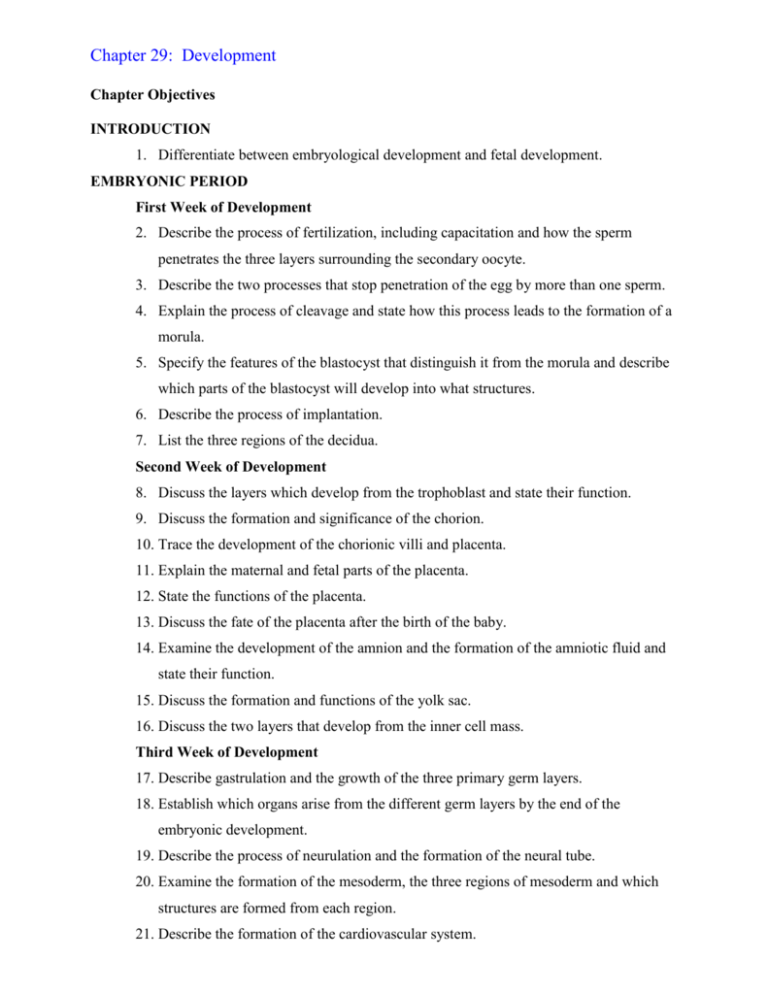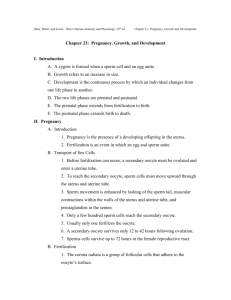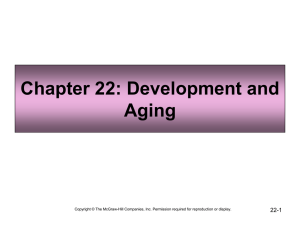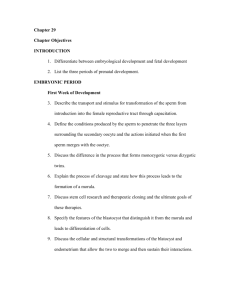Chapter 29
advertisement

Chapter 29: Development Chapter Objectives INTRODUCTION 1. Differentiate between embryological development and fetal development. EMBRYONIC PERIOD First Week of Development 2. Describe the process of fertilization, including capacitation and how the sperm penetrates the three layers surrounding the secondary oocyte. 3. Describe the two processes that stop penetration of the egg by more than one sperm. 4. Explain the process of cleavage and state how this process leads to the formation of a morula. 5. Specify the features of the blastocyst that distinguish it from the morula and describe which parts of the blastocyst will develop into what structures. 6. Describe the process of implantation. 7. List the three regions of the decidua. Second Week of Development 8. Discuss the layers which develop from the trophoblast and state their function. 9. Discuss the formation and significance of the chorion. 10. Trace the development of the chorionic villi and placenta. 11. Explain the maternal and fetal parts of the placenta. 12. State the functions of the placenta. 13. Discuss the fate of the placenta after the birth of the baby. 14. Examine the development of the amnion and the formation of the amniotic fluid and state their function. 15. Discuss the formation and functions of the yolk sac. 16. Discuss the two layers that develop from the inner cell mass. Third Week of Development 17. Describe gastrulation and the growth of the three primary germ layers. 18. Establish which organs arise from the different germ layers by the end of the embryonic development. 19. Describe the process of neurulation and the formation of the neural tube. 20. Examine the formation of the mesoderm, the three regions of mesoderm and which structures are formed from each region. 21. Describe the formation of the cardiovascular system. Fourth Week of Development 22. Examine how embryonic folding converts the embryo to a three dimensional cylinder. 23. Trace the organ development that occurs during the fourth week of development. Fifth Through the Eighth Weeks of Development 24. Match the events in the rapid development of the embryo with the week it occurs during this period. FETAL PERIOD 25. Discuss the development of the fetus, which occurs during this period. Reference the pages indicated in the text that discuss the development of the various body systems. HORMONES OF PREGNANCY 26. Compare the sources and functions of the hormones secreted during pregnancy. LABOR 27. Outline the hormonal and neural regulation of the duration of pregnancy. 28. Describe the characteristics of the three stages of labor. ADJUSTMENTS OF THE INFANT AT BIRTH 29. Discuss the respiratory system adjustments of the infant at birth. 30. Discuss the cardiovascular system adjustments of the infant at birth. Chapter Lecture Notes Introduction Prenatal development - the time from fertilization until birth divided into three trimesters Embryonic period - the first two months (8 weeks) following fertilization the developing human is referred to as an embryo Fetal period - from week nine until birth the developing human is referred to as a fetus Fertilization Fertilization – the merger of oocyte and sperm (Fig 29.1) Oocyte - ovulated from ovary and then transported through the uterine tube Sperm - swim up the uterus and into the uterine tube by the whip like movements of their tails (flagella) and muscular contractions of the uterus Capacitation - final maturation of the sperm in preparation of fertilization acrosomal membrane becomes fragile allows sperm to fertilize a secondary oocyte occurs 6 to 8 hours after deposited in female Fertilization normally occurs in the uterine tube within 12 to 24 hours after ovulation A sperm must penetrate the corona radiata and zona pellucida around the oocyte A glycoprotein in the zona pellucida (ZP3) acts as a sperm receptor triggers the acrosomal reaction - release of the contents of the acrosome onto the zona pellucida Acrosomal enzymes digest a path through the zona pellucida allowing only one sperm to reach the oocyte’s plasma membrane Sperm enters a secondary oocyte The oocyte completes meiosis The male DNA and female DNA combine forming the fertilized ovum or zygote Syngamy - fusion of a sperm with a secondary oocyte First sperm to fuse with oocyte membrane triggers the slow & the fast block to polyspermy Fast block to polyspermy - 1-3 seconds after contact, oocyte membrane depolarizes & other cells can not fuse with it Slow block to polyspermy - depolarization triggers the intracellular release of Ca+2 causing the exocytosis of molecules hardening the entire zona pellucida First Week of Development Cleavage – early cell division of a zygote (Fig 29.2 & 29.5) cells become progressively smaller blastomeres - cells produced by cleavage 1st cleavage (30 hours) produces 2 blastomeres (2 cell embryo) 2nd cleavage (Day 2) produces 4 cell embryo 16 cell embryo (Day 3) morula (Day 4) - solid mass of more than 16 cells blastocyst (Day 5) – a hollow ball of cells developed from a morula that has the following structures trophoblast cells - will form the future embryonic membranes & fetal portion of placenta trophoblast secretes human chorionic gonadotropin (hCG) that helps the corpus luteum maintain the uterine lining inner cell mass or embryoblast cells - the future embryo blastocele - an internal fluid-filled cavity enters the uterine cavity by day 5 Implantation Implantation – attachment of a blastocyst to the endometrium (Fig 29.3, 29.5 & 29.6) the blastocyst remains free with the cavity of the uterus for two to four days hatching – breakdown and shedding of the zona pellucida by the blastocyst implantation occurs seven to eight days after fertilization Following implantation the endometrium is known as the decidua and consists of three regions: Decidua basalis - between the chorion and the stratum basalis of the uterus (Fig 29.4) becomes the maternal part of the placenta Decidua capsularis - covers the embryo and is located between the embryo and the uterine cavity Decidua parietalis - lines the noninvolved areas of the entire pregnant uterus Decidua capsularis fuses with decidua parietalis as fetus grows Following preganancy, all of decidua is lost with the placenta Second Week of Development Trophoblast forms (Fig 29.6, 29.10 & 29.11) Chorion Amnion Amnionic cavity these structure start formation at week 2 but continue development and persist throughout entire pregnancy Chorion becomes the embryonic contribution to the placenta secretes human chorionic gonadotropin (hCG) chorionic villi - projections of the trophoblast that eventually contain blood filled capillaries Umbilical cord – connection of blood vessels in the chorionic villi to the embryonic heart starts as a connecting stalk with primitive connective tissue 1 umbilical vein carries oxygenated blood to the fetus from the chorionic villi 2 umbilical arteries carry blood to the chorionic villi in the placenta Placenta - chorionic villi from fetus + decidua basalis from the mother Chorionic villi extend into maternal blood filled intervillous spaces in the decidua basalis maternal & fetal blood vessels do not join & blood does not mix diffusion of O2, nutrients, wastes stores nutrients & produces hormones barrier to microorganisms, except some viruses AIDS, measles, chickenpox, poliomyelitis, encephalitis not a barrier to drugs such as alcohol Placenta fully forms during 3rd month After the birth of the baby, placenta detaches from the uterus (afterbirth) Amnion thin, protective membrane Initially the amnion overlies only the bilaminar embryonic disc Eventually the amnion surrounds the entire embryo creating the amniotic cavity contains amnionic fluid filtrate of mother’s blood + fetal urine shock absorber regulates body temperature prevents adhesions Yolk sac - an exocoelmic structure formed in the former blastocyst cavity (with the hypoblast) transfers nutrients to the embryo site of early blood formation gives rise to gonadal stem cells (spermatogonia & oogonia) allantois - outpocketing off yolk sac that becomes part of the umbilical cord Bilaminar embryonic disc - two layers of cells of the inner cell mass hypoblast primitive endoderm borders yolk sac epiblast primitive ectoderm borders amnionic cavity Third Week of Development Gastrulation – formation of tri-laminar disc (Fig 29.7 & 29.8) Primitive streak – first step of gastrulation Cells of the epiblast move inward below the primitive streak and detach from the epiblast Cells of the embryonic disc produce 3 distinct layers (Table 29.1) endoderm epithelial lining of GI & respiratory mesoderm muscle, bone & other connective tissues ectoderm epidermis of skin & nervous system Induction – development of a particular structure due to the stimulation received from a neighboring structure the development of the nervous tissue is due to induction Notochord - a solid cylinder of mesoderm cells that sends signals to the overlying ectoderm signaling it to become nervous tissue Neurulation (Fig 29.9) Neural plate – ectoderm cell located over the notochord Neural folds and neural groove – formed from the neural plate the neural folds will fuse to form the neural tube Neural crest cells - ectoderm cells that migrate and give rise to spinal and cranial nerves and their ganglia autonomic nervous system ganglia the meninges of the brain and spinal cord the adrenal medullae several skeletal and muscular components of the head Mesoderm (Fig 29.9 & 29.14) Paraxial mesoderm - Somites - a series of paired, cube-shaped structures 42-44 pairs of somites will develop Each somite has three regions Myotome – skeletal muscle of neck, trunk and limbs Dermatome – connective tissue including dermis of skin Sclerotome – vertebrae and ribs Intermediate mesoderm Gonads and kidneys Lateral plate mesoderm Splanchnic mesoderm Heart Visceral layers of the pericardium, pleurae, and peritoneum Blood vessels Smooth muscle and connective tissue of the respiratory and digestive system Somatic mesoderm Bones Ligaments Dermis of the limbs Parietal layers of the pericardium, pleurae, and peritoneum Development of the cardiovascular system Angiogenesis - the formation of blood vessels begins in the yolk sac and chorion Blood islands - isolated masses of aggregated blood forming cells Angioblasts – cells that form the walls of the blood vessels Spaces in the blood islands form the lumen of blood vessels The heart forms in the cardiogenic area of the splanchnic mesoderm Mesodermal cells form a pair of endocardial tubes The tubes fuse to form a single primitive heart Fourth week of Development Embryonic folding converts the embryo from a flat, two-dimensional trilaminar embryonic disc to a three-dimensional cylinder. (Fig 29.12, 29.13 & 29.14) Development of the somites and the neural tube occurs during the fourth week. Several pharyngeal (branchial) arches develop on each side of the future head and neck regions. With the pharyngeal clefts and pouches they will form structures of the head and neck. Otic placode - the first sign of a developing ear Lens placode - the first sign of a developing eye The upper limb buds appear in the middle of the fourth week and the lower limb buds appear at the end of the fourth week. Fifth Through Eight Weeks of Development During the fifth week there is rapid brain development and considerable head growth. During the sixth week the head grows even larger in relation to the trunk, there is substantial limb growth, the neck and truck begin to straighten, and the heart is now four-chambered. During the seventh week the various regions of the limbs become distinct and the beginnings of the digits appear. By the end of the eighth week all regions of the limbs are apparent, the digits are distinct, the eyelids come together, the tail disappears, and the external genitals begin to differentiate. Fetal Period During the fetal period, tissue and organs that developed during the embryonic period grow and differentiate. The rate of body growth is remarkable. A summary of the major developmental events of the fetal period is presented in Table 29.2 and Figure 29.02. Hormones of Pregnancy Chorion Human chorionic gonadotropin (hCG) (Fig 29.16) secreted by chorion from day 8 until 4 months mimics LH keeps corpus luteum active Corpus luteum progesterone & estrogen maintain lining of uterus necessary for the continued attachment of the embryo and fetus to the lining of the uterus Placenta progesterone & estrogen by 4th month produces enough that corpus luteum is no longer important relaxin Increases flexibility of pubic symphysis Dilates the uterine cervix during labor inhibits secretion of FSH and might regulate secretion of hGH human chorionic somatomammotropoin (hCS) or human placental lactogen (hPL) maximum amount by 32 weeks role in breast development for lactation, protein anabolism, and catabolism of glucose and fatty acids corticotropin-releasing hormone (CRH) increases secretion of fetal cortisol (lung maturation) thought to be the “clock” that establishes the timing of birth Labor and Parturition Parturition means giving birth Labor is the process of expelling the fetus progesterone inhibits uterine contraction and labor placenta stimulates fetal anterior pituitary which causes fetal adrenal gland to secrete dehydroepiandrosterone (DHEA) placenta converts DHEA to estrogen the elevated levels of estrogens, plus elevated prostaglandins, oxytocin, and relaxin; and a decrease in progesterone levels are all probably involved in the initiation and progression of labor True labor begins when uterine contractions occur at regular intervals, usually producing pain Other signs of true labor may be localization of pain in the back, which are intensified by walking, dilation of the cervix “show” - discharge of blood-containing mucus from the cervical canal Uterine contraction forces fetal head into cervix (stretch) Nerve impulses reach hypothalamus causing release of oxytocin Oxytocin causes more contractions producing more stretch of cervix & more nerve impulses Stages of Labor (Fig 29.18) Dilation 6 to 12 hours regular contractions of the uterus rupture of amniotic sac & dilation of cervix (10cm) Expulsion 10 minutes to several hours baby moves through birth canal Placental 30 minutes afterbirth is expelled by uterine contractions constrict blood vessels that were torn reduce the possibility of hemorrhage Puerperium – a period of time after delivery of the baby and placenta about six weeks after delivery reproductive organs and maternal physiology return to the prepregnancy state uterus undergoes involution lochia - uterine discharge of blood and serous fluid for two to four weeks after delivery Adjustments of the Infant at Birth Fetal adrenal medullae of secretes high levels of epinephrine and norepinephrine afford the fetus protection against the stresses of the birth process prepare the infant to survive extrauterine life Respiratory System after cord is cut, increased CO2 levels in blood respiratory center in the medulla is stimulated causes muscular contractions and first breath breathing rate begins at 45/minute for the first 2 weeks & declines to reach normal rate Cardiovascular System foramen ovale closes at moment of birth diverts deoxygenated blood to the lungs for the first time remnant of the foramen ovale is the fossa ovalis ductus arteriosus & umbilical vein close down by muscle contractions & become ligaments ligamentum arteriosum is the remnant of the ductus arteriosus ligamentum venosum is the remnant of the ductus venosus pulse rate slows down (120 to 160 at birth) increase in the rate of erythrocyte and hemoglobin production for several days after birth due to a greater need for oxygen This increase usually lasts for only a few days white blood cell count at birth is very high 45,000 cells per cubic millimeter decreases rapidly by the seventh day








